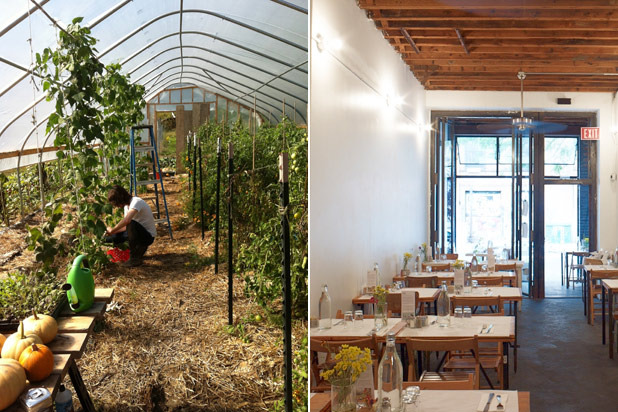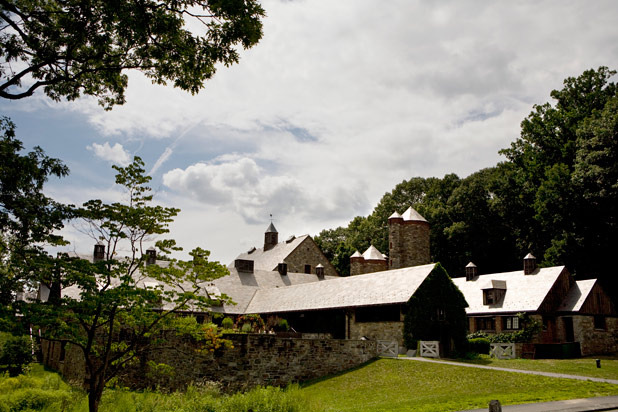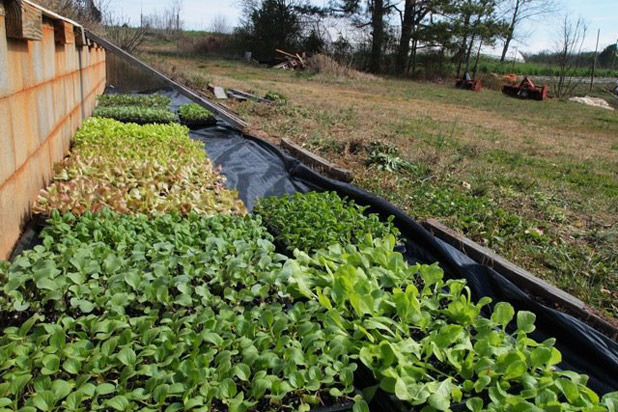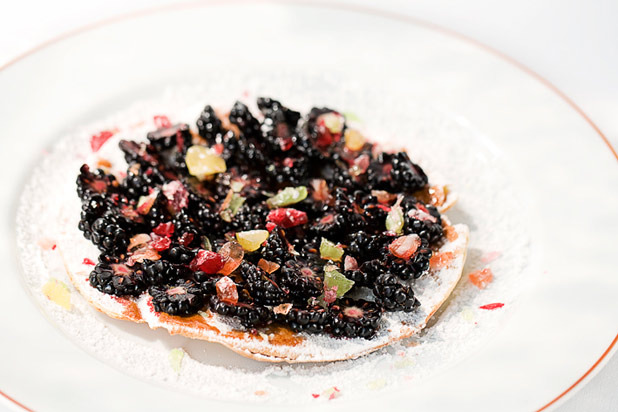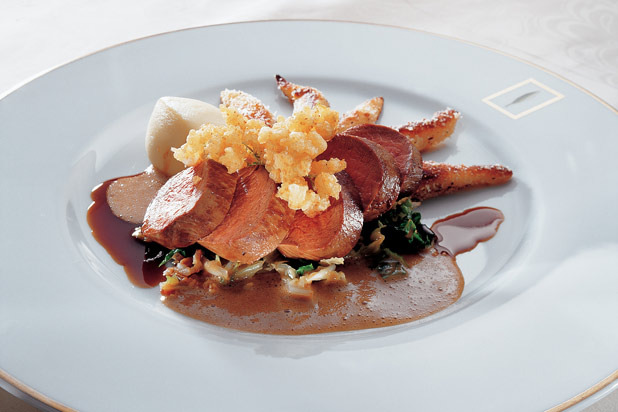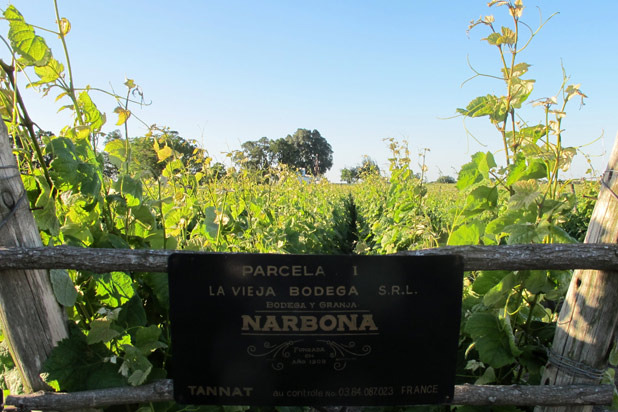See Beyond Locally Sourced: 9 Restaurants With Farms
George Weld dreamed of starting his own farm, but the restaurant came first. In 2005 he opened his Brooklyn breakfast hot spot Egg , but his farming daydreams endured. Goatfell Farm was started shortly after, and it grew quickly from a small vegetable patch to a full-scale operation in the Catskills. The amount of produce that Egg and Weld's recently opened Parish Hall source from Goatfell Farm varies from week to week, and the restaurants continue to support other local farms. It's clear, however, that Goatfell Farm and the Egg family have a tight-knit connection, with staff volunteering on the farm regularly and staying closely involved in the farm's operations.
Blue Hill and Stone Barns (Tarrytown, N.Y.)
Chef Dan Barber opened Blue Hill in 2004 within the Stone Barns Center for Food and Agriculture, an 80-acre farm 30 miles north of Manhattan, and the restaurant continues to be a model for cuisine grounded in local and seasonal sourcing. Stone Barns Center for Food and Agriculture is a not-for-profit that Blue Hill does not own, but the restaurant's location at the working farm helps tell the full story of the ingredients to diners. About 70 percent of the products Blue Hill purchases come from Stone Barns, and the rest is sourced from 60 other local purveyors and farmers, including Barber's own family dairy farm Blue Hill Farm in Great Barrington, Mass.
Manresa (Los Gatos, Calif.)
Chef David Kinch's interest in the terroir of the California coast led him to form a partnership with Love Apple Farms, a biodynamic farm located a few miles from the restaurant. Each morning, the vegetables are harvested and then find their way onto Manresa'smenu that same day. Like any good partnership, the relationship with Manresa has helped Love Apple Farms to grow, allowing owner Cynthia Sandberg to increase the varieties of produce she grows, move to a larger property, and expand her educational offerings.
Farm 255 (Athens, Ga.)
Farm 255 was founded as an extension of Full Moon Farms and, later on, Moonshine Meats, a collective of sustainable livestock farmers in Georgia.
"The restaurant was created with the idea to create a symbiotic relationship [between restaurant and farm]," said managing partner Olivia Sergeant. Depending on the growing season, 20 to 50 percent of the vegetables and meat served at Farm 255 are grown on Full Moon Farms. While others might struggle to keep both a farm and restaurant enterprise alive, Sergeant explains that the "symbiotic but independent" relationship between the two allows each business to thrive on its own.
"The key to success is being a tight business person," she points out. "Then you can make any model work." And the Athens, Ga., community is certainly benefiting from the harvest of Farm 255's know-how.
L’Arpège (Paris)
Chef Alain Passard has an artist's fascination with the vegetables he uses in his cooking, an interest that led him to start a biodynamic garden outside of Paris to grow the produce he uses at his three-Michelin-starred restaurant L'Arpège. The seasonal, vegetable-forward menu, masterfully pulled off with the best of French technique, is worth a pilgrimage.
L’Enclume (Cumbria, England)
Three and a half years ago, L'Enclume had the opportunity to take over a farm that was in disrepair. Two and a half years later, the restaurant acquired a larger space, allowing them to have full control over the products they source. All of the produce served in the restaurant is grown on the farm, and the availability of ingredients dictates the daily-changing menu. Even better, the restaurant is part of a bed-and-breakfast, making for the perfect locavore getaway.
Gasthaus zum Gupf (Rehetobel, Switzerland)
Chef Daniel Humm of New York City's Eleven Madison Park fame cut his teeth at Gasthaus zum Gupf, where he earned his first Michelin star. The restaurant and inn is located in the Appenzell Mountains surrounded by farmland, where the Zähner family raises pigs and cattle used on the restaurant's menu. Chef Walter Klose carries the fine dining torch, and while the restaurant's product needs are greater than what the farm can produce by itself, the farm continues to be an integral part of Gasthaus zum Gupf's gastronomic identity.
Annie Smithers' Bistrot (Kyneton, Australia)
Annie Smithers' kitchen garden is proof that a lot can come out of an acre. The one-acre piece of land supplies up to 90 percent of the produce served at Annie Smithers' Bistrot. The French bistro-inspired menu changes daily, according to the harvest.
Finca Narbona (Carmelo, Uruguay)
The agricultural estate of Finca Narbona dates back to the 18th century, and today it continues its tradition as a working dairy farm, winery, and small inn. The restaurant's fixed menu serves food and wine produced on the farm. Expect family-style classic pasta dishes, cheese made onsite, and wine from the estate cellars.
